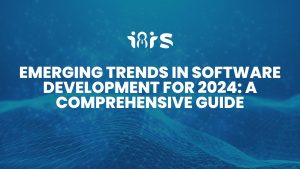Cloud computing service trends are visibly shaping the landscape of application and infrastructure software, business processes, and system infrastructure. Expenditure on cloud computing has soared to nearly $55 billion, marking a significant increase from the previous year and underscoring its growing importance.
Gartner’s survey reveals that 48% of tech companies are investing in cloud computing technology innovations, highlighting the industry’s dedication to remaining at the forefront of technological advancements. This article will explore innovations in cloud computing technologies and their business applications.
What is Cloud Computing? Cloud computing involves the on-demand delivery of IT resources over the Internet with pay-as-you-go pricing. It encompasses accessing computing resources such as servers, storage, databases, and networking without the need for physical ownership or maintenance.
Innovations in Cloud Computing and Their Business Applications Cloud computing services have undergone continual innovation, leading to transformative changes in the way businesses operate and leverage technology. Here are some key innovations in cloud computing and their significant business applications:
Serverless Computing:
- Innovation: Serverless computing enables developers to run code without explicitly provisioning or managing servers, automatically scaling based on demand.
- Business Applications: This reduces infrastructure costs, facilitates rapid development, and ensures efficient resource utilization, particularly suitable for event-driven applications and microservices architecture.
Edge Computing:
- Innovation: Edge computing involves processing data closer to its source of generation, reducing latency and enhancing real-time capabilities.
- Business Applications: Essential for applications requiring low-latency responses, such as IoT devices, augmented reality (AR), and autonomous vehicles.
Multi-Cloud and Hybrid Cloud Solutions:
- Innovation: Organizations utilize multiple cloud service providers or a combination of public and private clouds to meet specific needs.
- Business Applications: This enhances flexibility, mitigates vendor lock-in risks, and enables businesses to select the most suitable cloud for different workloads.
Containers and Kubernetes:
- Innovation: Containers encapsulate applications and their dependencies, while Kubernetes orchestrates containerized applications for efficient deployment and scaling.
- Business Applications: This streamlines application deployment, ensures consistency across various environments, and facilitates efficient resource utilization.
AI and Machine Learning Integration:
- Innovation: Cloud providers offer AI and machine learning services, enabling businesses to integrate advanced analytics and predictive capabilities into their applications.
- Business Applications: Enhancing decision-making, automating processes, and enabling businesses to derive insights from large datasets.
Quantum Computing Services:
- Innovation: Cloud providers are exploring quantum computing services, leveraging the principles of quantum mechanics for complex computations.
- Business Applications: Potential applications include cryptography, optimization problems, and simulations that surpass classical computing capabilities.
Cloud-Native Development:
- Innovation: Cloud-native development involves building and deploying applications designed specifically for cloud environments.
- Business Applications: This improves scalability, resilience, and agility, accelerating time-to-market for new features and services.
Blockchain as a Service (BaaS):
- Innovation: Cloud providers offer blockchain platforms as a service, simplifying the development and deployment of blockchain applications.
- Business Applications: Enhancing transparency, security, and traceability in supply chain management, financial transactions, and smart contracts.
Secure Access Service Edge (SASE):
- Innovation: SASE combines network security functions with WAN capabilities to support the dynamic, secure access needs of organizations.
- Business Applications: Addressing the evolving security requirements of remote workforces, providing secure access to cloud resources.
Automated DevOps Pipelines:
- Innovation: Cloud services automate various stages of the DevOps process, from code integration and testing to deployment and monitoring.
- Business Applications: This improves collaboration between development and operations teams, accelerates software delivery, and enhances overall efficiency.
Cloud Computing Services Cloud computing services have become the foundation of the digital era, offering businesses unparalleled flexibility, scalability, and efficiency. These services can be categorized into three main types, each catering to distinct needs and preferences.
Infrastructure as a Service (IaaS):
- Definition: IaaS empowers users to rent IT infrastructure components such as storage, networking, and servers on a pay-as-you-go basis.
- Key Players: Amazon Web Services (AWS), Microsoft Azure, Google Cloud Platform (GCP).
- Use Case: Ideal for organizations requiring scalable and on-demand computing resources without the burden of physical infrastructure.
Platform as a Service (PaaS):
- Definition: PaaS provides users with a cloud-based platform to develop, run, and manage applications, including essential components like web servers, databases, and development tools.
- Key Players: Heroku, AWS Elastic Beanstalk, Google App Engine.
- Use Case: Suited for developers aiming to streamline the application development process without managing the underlying infrastructure.
Software as a Service (SaaS):
- Definition: SaaS allows users to access and utilize cloud-based software applications through web browsers, eliminating the need for installation and software management.
- Key Players: Google Docs, Microsoft Office 365, Salesforce.
- Use Case: Perfect for businesses seeking ready-to-use software solutions without the hassle of maintenance and updates.
Deployment Models: Public Cloud:
- Definition: Services are delivered over the public Internet by third-party providers like AWS, Azure, and GCP.
- Characteristics: Cost-effective, scalable, and accessible to the general public.
Private Cloud:
- Definition: Services are delivered over a private network and owned/operated by enterprises, either on-premises or off-premises.
- Characteristics: Enhanced security, control, and customization for specific organizational needs.
Hybrid Cloud:
- Definition: Services are delivered over a combination of public and private networks, utilizing both on-premises and third-party resources.
- Characteristics: Offers flexibility, allowing organizations to optimize resources based on specific requirements.
As businesses increasingly embrace digital transformation, cloud computing services provided by cloud computing service providers have become indispensable tools, driving innovation and shaping the future of IT infrastructure. Whether opting for IaaS, PaaS, or SaaS, and choosing between public, private, or hybrid models, organizations can tailor their cloud strategies to meet evolving demands and stay ahead in today’s dynamic business landscape.
Conclusion As we’ve explored the dynamic realm of cloud computing innovations, it’s evident that these advancements offer transformative potential for businesses. From increased efficiency and scalability to enhanced security and cost savings, the capabilities of modern cloud services are reshaping the corporate landscape.
Embracing these technologies isn’t just about staying current – it’s about pioneering a future in which your business thrives in the digital age.





